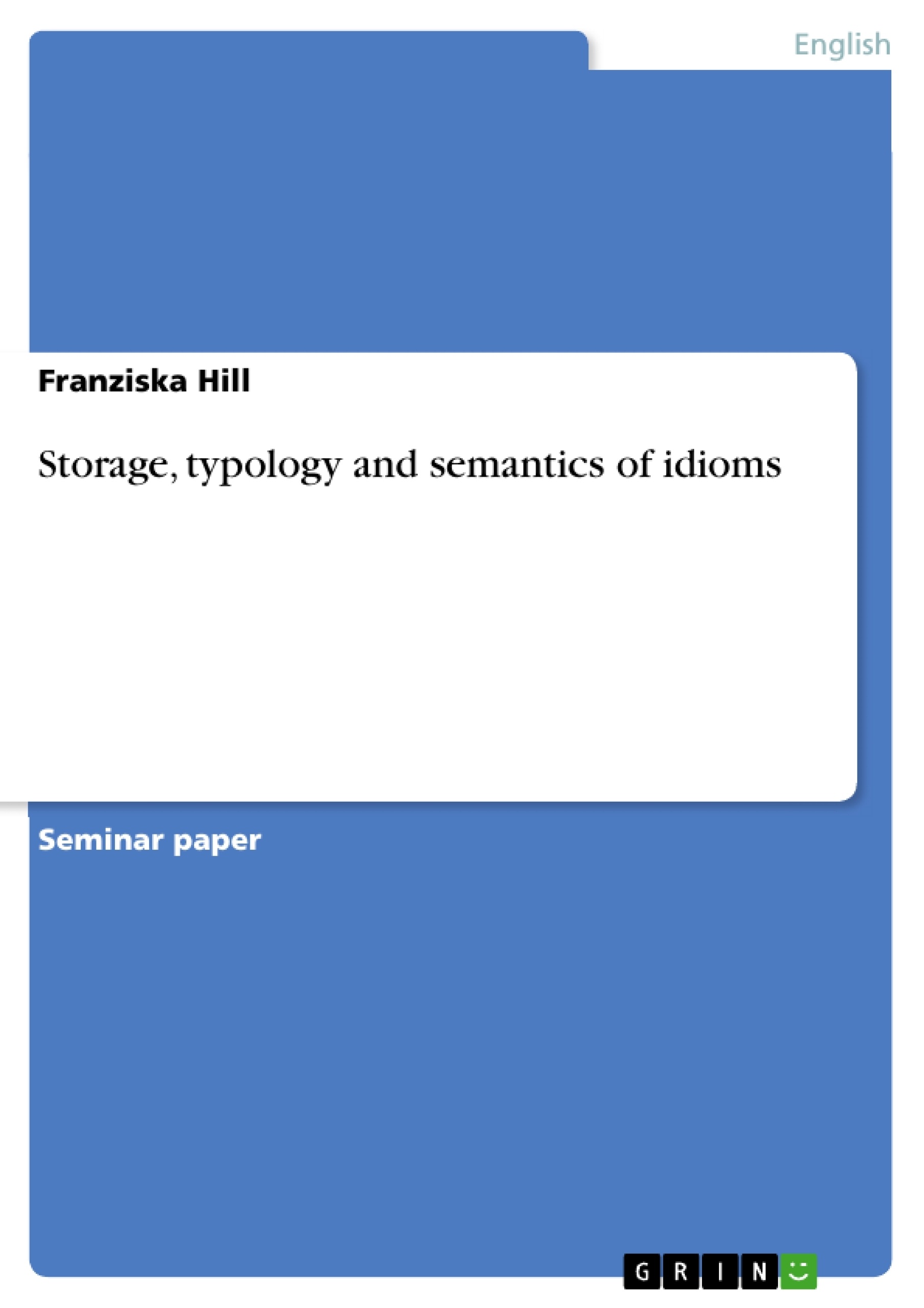“Such expressions are termed idioms, defined as groups of words with set meanings that cannot be calculated by adding up the separate meanings of the parts” (Heidi Anders 1995, 17).
Idioms have a semantic productivity which means ‘die wendungsinternen Bedeutungen einzelner Idiom-Konstituenten werden beim Konstruieren der Äußerung produktiv eingesetzt’ and a discourse productivity: the possibility to interpret the constituents of an idiom as autonomous, semantically ambivalent entities (Dobrovols’kij 1997, 22). An idiom can also be seen as a lexical unit, which formally consists of several words, but semantically be a whole and will be treated and saved like words. (Dobrovols’kij 1997, 51) There is a great variety within idioms of their degree of flexibility anyhow an idiom is a lexical unit.
Everybody intuitively can realize an idiom as an idiom because of different characteristics, e.g. several combinations and different intension. All fixed word-complexes are reproducible. Idioms are an open class, in the core there are the more idiomaticised idioms and in the periphery they are less idiomatic. But if the hearer does not know an idiom, it is no idiom. Idioms differ in relation to proverbs mainly in semiotic-semantic parameters. Proverbs have a discursive autonomy and are quoted as ‘texts’, idioms instead are reproduced as lexical units. Another difference is that proverbs verbalize ‘general truth’ and fall back on shared knowledge of the people.
An idiom comes into existence if one uses a phrase or sentence about a common situation or object in a figurative manner. The phrase has to be especially to the point, expressive or pictographic. This new expression will be consolidated and lexicalised and after that it will be taken into normal speech. Most idioms are stylistically neutral, but they can also be on a stylisticly lower or higher level. Archaic, literary, foreign and formal words belong to the higher level, whereas colloquial, jargon, slang and vulgar words belong to the lower level. Especially the lower level is highly idiomaticised.
The usage of idioms plays a role in the social positioning of conversational partners and to consolidate a social hierarchy. An idiom is more informative than its simple lexical counterpart.
Inhaltsverzeichnis (Table of Contents)
- Definition of the term idiom
- Order of the mental procedures while working out idioms
- The literal-first model
- The figurative-first model
- The simultaneous processing model
- Storage of idioms
- The lexical representation theory
- The configuration hypothesis
- The decomposition hypothesis
- Typology of idioms
- Functional idiom-typology by Cacciari & Glucksberg
- Appendages for a communicative-functional typology of idioms
- Semantics of idioms
- Semantic valence of idiom constituents
- Grammatical criterions of idiomaticity
- Idioms and motivation
- Degree of idiomaticity
- Analysis
Zielsetzung und Themenschwerpunkte (Objectives and Key Themes)
This text explores the fascinating world of idioms, focusing on their definition, interpretation, and storage in the human mind. It examines various models of how idioms are processed, from literal-first to simultaneous processing, and analyzes the different theories of how idioms are stored in the mental lexicon. The text also delves into the typology of idioms, exploring their functional and communicative aspects.
- Definition and Characteristics of Idioms
- Models of Idiom Processing
- Theories of Idiom Storage in the Mental Lexicon
- Typology and Semantics of Idioms
- The Relationship between Idioms and Motivation
Zusammenfassung der Kapitel (Chapter Summaries)
- Definition of the term idiom: This chapter introduces the concept of idioms, defining them as fixed expressions with meanings that cannot be derived from the individual words within them. It explores the semantic and discourse productivity of idioms, highlighting their role as lexical units with distinct meanings.
- Order of the mental procedures while working out idioms: This chapter examines different models of how people interpret idioms. The literal-first model suggests that people first attempt to interpret an idiom literally, while the figurative-first model proposes that they directly access the figurative meaning. The simultaneous processing model suggests that both literal and figurative meanings are processed concurrently.
- Storage of idioms: This chapter explores various theories of how idioms are stored in the mental lexicon. The lexical representation theory suggests that idioms are stored as individual units, similar to words. The configuration hypothesis proposes that idioms are stored as configurations of elements, while the decomposition hypothesis suggests that some idioms can be broken down into meaningful parts.
- Typology of idioms: This chapter investigates different classifications of idioms based on their function and communicative properties. It examines the functional idiom-typology proposed by Cacciari & Glucksberg and discusses the development of a communicative-functional typology.
- Semantics of idioms: This chapter delves into the semantic aspects of idioms, exploring the semantic valence of individual components within an idiom and the grammatical criteria that contribute to its idiomaticity.
Schlüsselwörter (Keywords)
Idioms, idiom processing, mental lexicon, idiom storage, semantic productivity, discourse productivity, lexical unit, figurative language, literal-first model, figurative-first model, simultaneous processing model, lexical representation theory, configuration hypothesis, decomposition hypothesis, functional idiom-typology, communicative-functional typology, semantic valence, grammatical criterions of idiomaticity.
- Arbeit zitieren
- Franziska Hill (Autor:in), 2004, Storage, typology and semantics of idioms, München, GRIN Verlag, https://www.grin.com/document/71028



